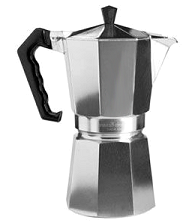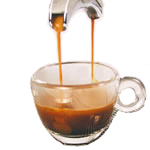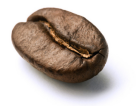How to make a great cup of coffee
Charisma Coffee desires that you understand, create and enjoy the perfect expression of our product. To that end, the instructions, tips and recipes below are presented for your use.
While freshness is a key element in making a great cup of coffee there are other processes involved:
![]() Bean quality
Bean quality
![]() Care and attention to detail in roasting*
Care and attention to detail in roasting*
![]() Freshness of the coffee
Freshness of the coffee
![]() Grind profile for the right equipment
Grind profile for the right equipment
![]() The artisan skill of the barista
The artisan skill of the barista
* Unroasted coffee is tasteless and aromaless. It is the roasting process which creates the coffee taste as we know it. 'Pyrolysis' is the technical name for the process whereby heat brings about chemical change in the beans, thus developing its complex flavours.
Flavour and aroma are not the only characteristics that coffee connoisseurs consider:
Body: Different coffees can feel thicker or heavier than others. Brewing methods can influence this perception of body. Espresso always feels thicker while a Chemex coffee would be regarded as delivering a lighter flavour.
Acidity: This characteristic refers not to pH levels but to the liveliness of a coffee detected at the front of the mouth.
Bitter: Sensed at the back of the mouth bitterness refers to the sharpness of flavour that persists as the after taste.
Winey: This refers to a coffee's smoothness and texture.
Each of the above characteristics is influenced by the types of beans roasted, how they were roasted, and the addition of milk.
When tasting coffee try it with and without milk. Lightly 'slurp' it into your mouth in order to aerate the liquid around your mouth to ensure that it makes contact with all the areas of your tongue. This technique will ensure that the different flavours of a coffee will be detected.
Proper plunger

![]() Bring the water to just below boiling point and give your plunger (French press) a quick swirl of the water to heat the class, and then tip it out.
Bring the water to just below boiling point and give your plunger (French press) a quick swirl of the water to heat the class, and then tip it out.
![]() The coffee should be a course grind as not to pass through the plungers wire mesh.
The coffee should be a course grind as not to pass through the plungers wire mesh.
![]() Add coffee - about 7g-10g per cup (a cup equals approximately 175-200ml). This is about one tablespoon per cup.
Add coffee - about 7g-10g per cup (a cup equals approximately 175-200ml). This is about one tablespoon per cup.
![]() Pour the hot water (90 deg C to 95 deg C) in from a height as to disturb the coffee and then stir gently.
Pour the hot water (90 deg C to 95 deg C) in from a height as to disturb the coffee and then stir gently.
![]() Place the lid on the container and rest the plunger on the top of the liquid.
Place the lid on the container and rest the plunger on the top of the liquid.
![]() Allow the coffee too steep for four minutes, press the plunger down gently, then pour to serve, ideally into a 90ml espresso cup of demitasse.
Allow the coffee too steep for four minutes, press the plunger down gently, then pour to serve, ideally into a 90ml espresso cup of demitasse.
![]() Your coffee can form the basis for many variations. Try some of the recipes.
Your coffee can form the basis for many variations. Try some of the recipes.
Percolator perfection

![]() Fill the base with water just below the pressure valve.
Fill the base with water just below the pressure valve.
![]() Place coffee into the filter basket to the top and scrap of excess. Ensure that the rim is free of coffee granules and that the seal of the upper chamber is properly seated and clean of grit. There is no need to tamp the coffee.
Place coffee into the filter basket to the top and scrap of excess. Ensure that the rim is free of coffee granules and that the seal of the upper chamber is properly seated and clean of grit. There is no need to tamp the coffee.
![]() Assemble both upper and lower brewer chambers together and place on over high heat - pre-heat the ring of an electric stove-top.
Assemble both upper and lower brewer chambers together and place on over high heat - pre-heat the ring of an electric stove-top.
![]() Shortly the coffee will flow into the top section. At first it will emerge as thick syrup and then gradually become thinner. At the point of a finer liquid, bubbling and frothing remove the brewer from heat. To continue past this point will result in an over extracted and bitter flavoured coffee.
Shortly the coffee will flow into the top section. At first it will emerge as thick syrup and then gradually become thinner. At the point of a finer liquid, bubbling and frothing remove the brewer from heat. To continue past this point will result in an over extracted and bitter flavoured coffee.
![]() Pour immediately, ideally into a 90ml espresso cup of demitasse. It should appear as syrup as you serve. If the coffee does not emerge as syrup the grind of the beans may have been to course. Alternatively to fine a grind and you may not receive much coffee out of the machine.
Pour immediately, ideally into a 90ml espresso cup of demitasse. It should appear as syrup as you serve. If the coffee does not emerge as syrup the grind of the beans may have been to course. Alternatively to fine a grind and you may not receive much coffee out of the machine.
![]() Your coffee can form the basis for many variations. Try some of the recipes.
Your coffee can form the basis for many variations. Try some of the recipes.
Excellent espresso

These instructions assume that a manual espresso machine is being used. 'Automatic' machines take care of everything for you, although they usually allow for grind adjustment, according to taste, to adjust strength.
![]() Use a 90ml espresso class or demitasse cup.
Use a 90ml espresso class or demitasse cup.
![]() In readiness for an espresso ensure that your grind is fine and that you fill the filter basket with 7-10g. Scrape off excess and tamp the coffee with a good degree of downward force/pressure (approximately 10kg of pressure to be more precise).
In readiness for an espresso ensure that your grind is fine and that you fill the filter basket with 7-10g. Scrape off excess and tamp the coffee with a good degree of downward force/pressure (approximately 10kg of pressure to be more precise).
![]() Use filtered water to eliminate impurities offering a more pure taste and greater protection for your machine.
Use filtered water to eliminate impurities offering a more pure taste and greater protection for your machine.
![]() The ideal extraction time for an espresso is 30 seconds and the perfect quantity is 30-35ml. Over and under times can be due to how course or fine the grind is and the tamp pressure. The coffee should not appear watery when flowing, but should be a deep colour with a crema forming immediately.
The ideal extraction time for an espresso is 30 seconds and the perfect quantity is 30-35ml. Over and under times can be due to how course or fine the grind is and the tamp pressure. The coffee should not appear watery when flowing, but should be a deep colour with a crema forming immediately.
![]() To weaken your coffee simply add hot water and for a stronger coffee simply shorten the time of extraction.
To weaken your coffee simply add hot water and for a stronger coffee simply shorten the time of extraction.
![]() Your coffee can form the basis for many variations. Try some of the recipes.
Your coffee can form the basis for many variations. Try some of the recipes.
Magnificent macchiato
In Italian, macchiato means "to stain or mark".
![]() Use a 90ml espresso glass or demitasse cup.
Use a 90ml espresso glass or demitasse cup.
![]() Add a single (30-35ml) of double (60-70ml) shot of espresso.
Add a single (30-35ml) of double (60-70ml) shot of espresso.
![]() Add a small dash of milk and top with a small dollop of milk foam in the middle of the crema; that is, 'mark' the top.
Add a small dash of milk and top with a small dollop of milk foam in the middle of the crema; that is, 'mark' the top.
Luxurious long black
![]() Use a 190ml cup or mug.
Use a 190ml cup or mug.
![]() Firstly, add hot water to taste. This avoids disturbing the crema of the espresso that follows.
Firstly, add hot water to taste. This avoids disturbing the crema of the espresso that follows.
![]() Carefully add a single (30-35ml) of double (60-70ml) shot of espresso.
Carefully add a single (30-35ml) of double (60-70ml) shot of espresso.
Fabulous flat white
![]() Use a 190ml cup.
Use a 190ml cup.
![]() Add a single (30-35ml) of double (60-70ml) shot of espresso.
Add a single (30-35ml) of double (60-70ml) shot of espresso.
![]() Pour in steamed milk so as to leave only a thin (2mm) layer of froth to seal the coffee.
Pour in steamed milk so as to leave only a thin (2mm) layer of froth to seal the coffee.
Charismatic cappuccino
![]() Use a 190-240ml cup.
Use a 190-240ml cup.
![]() Add a single (30-35ml) of double (60-70ml) shot of espresso.
Add a single (30-35ml) of double (60-70ml) shot of espresso.
![]() Add the foamed milk so the ratio is approximately two-thirds milky coffee to one third froth.
Add the foamed milk so the ratio is approximately two-thirds milky coffee to one third froth.
![]() Dust with drinking chocolate.
Dust with drinking chocolate.
Luscious Latte
![]() Use a 220ml glass or cup.
Use a 220ml glass or cup.
![]() Add a single (30-35ml) of double (60-70ml) shot of espresso.
Add a single (30-35ml) of double (60-70ml) shot of espresso.
![]() Pour in steamed milk to create a 10mm layer of froth to seal the coffee.
Pour in steamed milk to create a 10mm layer of froth to seal the coffee.
Caffe Mocha magic
![]() Use a 190-240ml cup.
Use a 190-240ml cup.
![]() Add a single (30-35ml) of double (60-70ml) shot of espresso.
Add a single (30-35ml) of double (60-70ml) shot of espresso.
![]() Mix in two teaspoons of drinking chocolate before adding the milk.
Mix in two teaspoons of drinking chocolate before adding the milk.
![]() Add the foamed milk so the ratio is approximately two-thirds milky chocolate-coffee to one third froth.
Add the foamed milk so the ratio is approximately two-thirds milky chocolate-coffee to one third froth.
![]() Dust with drinking chocolate or mark the foam with thin chocolate topping.
Dust with drinking chocolate or mark the foam with thin chocolate topping.
Ristretto
Similar in concept to a standard espresso but focusses on the sweetest, purest and most intense part of the extraction using a coffee machine (ie, not plunger or percolator).
![]() Use a demitasse cup.
Use a demitasse cup.
![]() Add only 15-20ml of the initial coffee extraction.
Add only 15-20ml of the initial coffee extraction.
Con Panna
This is a variation on Vienna coffee, and literally means "with cream".
![]() Best suited to a 190ml cup
Best suited to a 190ml cup
![]() Use a single (30-35ml) of double (60-70ml) shot of espresso.
Use a single (30-35ml) of double (60-70ml) shot of espresso.
![]() Add lightly whipped cream to the top to suit taste. Avoid pressure pack cream!
Add lightly whipped cream to the top to suit taste. Avoid pressure pack cream!
![]() Dust lightly with either cinnamon or drinking chocolate.
Dust lightly with either cinnamon or drinking chocolate.
Amazing Affogato

Not really a coffee, but a dessert, which is well worth trying!
![]() Serve a scoop of vanilla (preferably quality vanilla bean) in a cup, bowl or glass.
Serve a scoop of vanilla (preferably quality vanilla bean) in a cup, bowl or glass.
![]() For each serve, one shot of espresso (30-35ml) to be poured over the ice cream before eating. For a true coffee lover, perhaps add a little more!
For each serve, one shot of espresso (30-35ml) to be poured over the ice cream before eating. For a true coffee lover, perhaps add a little more!
![]() As an option, add about a nip (30ml) of either Frangelico or Kahlua, to taste.
As an option, add about a nip (30ml) of either Frangelico or Kahlua, to taste.
![]() As a dessert, it is eaten with a spoon.
As a dessert, it is eaten with a spoon.
Adding texture: foaming tips
To add texture to the milk, foam is created by frothing of milk with steam. The steam both heats the milk and mixes it with air to form the silky texture, or foam of fine bubbles.
![]() Before starting, purge the steam nozzle with a full blast over the drip tray. This will eliminate any condensed water in the line spoiling the coffee.
Before starting, purge the steam nozzle with a full blast over the drip tray. This will eliminate any condensed water in the line spoiling the coffee.
![]() For best results use a clean stainless steel jug and cold, fresh milk.
For best results use a clean stainless steel jug and cold, fresh milk.
![]() Whilst espresso coffee is the basis of all coffees, milk is most often the key variable. Determine how much milk is required for the number of serves for a given recipe. The volume of the milk will increase as it is foamed. One to two-thirds of a jug of milk is sufficient to allow for 'stretching'.
Whilst espresso coffee is the basis of all coffees, milk is most often the key variable. Determine how much milk is required for the number of serves for a given recipe. The volume of the milk will increase as it is foamed. One to two-thirds of a jug of milk is sufficient to allow for 'stretching'.
![]() Place the steam nozzle just under the surface of the milk and run steamer for approximately 5 seconds before moving the jug up the nozzle to further heat the milk.
Place the steam nozzle just under the surface of the milk and run steamer for approximately 5 seconds before moving the jug up the nozzle to further heat the milk.
![]() The milk should not be heated beyond 70 deg C for ease of drinking and to avoid scolding the milk (60 deg C to 65 deg C is ideal) . At around 72 deg C, the milk may start to boil and all texture will be lost. Boiled milk will also affect the taste of the coffee. A good test of temperature is when you can no longer hold the bottom/side of the jug.
The milk should not be heated beyond 70 deg C for ease of drinking and to avoid scolding the milk (60 deg C to 65 deg C is ideal) . At around 72 deg C, the milk may start to boil and all texture will be lost. Boiled milk will also affect the taste of the coffee. A good test of temperature is when you can no longer hold the bottom/side of the jug.
![]() Avoiding lifting the nozzle in and out of the milk whilst texturising. This results in 'gulps' of air creating large bubbles in the milk which are unsightly, poor in texture, and go 'flat' very quickly.
Avoiding lifting the nozzle in and out of the milk whilst texturising. This results in 'gulps' of air creating large bubbles in the milk which are unsightly, poor in texture, and go 'flat' very quickly.
![]() Pour the milk straight away so as not allow the coffee to cool down too much as this will affect its flavour.
Pour the milk straight away so as not allow the coffee to cool down too much as this will affect its flavour.
![]() The amount of foam required varies according to the coffee recipe. Cappuccino requires more foam than a flat white.
The amount of foam required varies according to the coffee recipe. Cappuccino requires more foam than a flat white.

